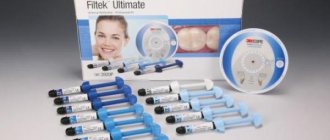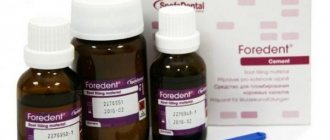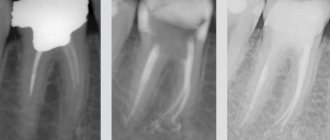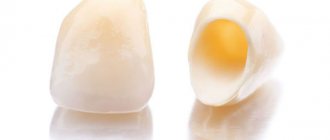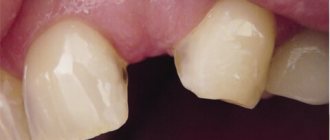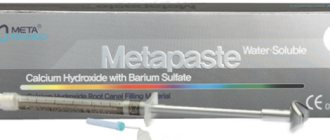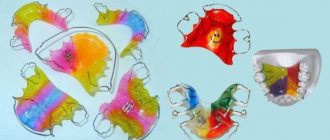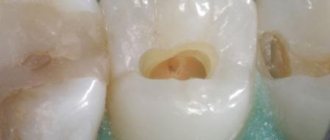Types of temporary fillings
You cannot do without a temporary filling in the following cases:
- For conservative treatment of not too advanced pulpitis and advanced caries. After drilling out the inflammatory focus and treating the root canals, the tooth cavity is filled with anti-inflammatory drugs, and a filling is placed on top. This is necessary so that the drug does not leak out and that microbes and pieces of food do not get into the diseased tooth.
- For diagnosis in deep caries, when it is unclear whether the nerve is affected. They put a filling with medicine and watch the tooth - if it continues to hurt, most likely it is pulpitis.
- In the treatment of pulpitis, if there is a need to remove the nerve. Then the treatment is carried out in 2 steps: first, a filling is placed with arsenic or other, more gentle devitalizing drugs, and after the death of the nerve, treatment is carried out.
- For prosthetics and restoration to protect teeth while permanent structures are being made.
Light-curing filling: advantages and installation features
A more accurate name for this dental composite material is photopolymer filling. The prefix “photo-” indicates that special light is needed to cure the filling, and polymers are composite materials.
A light filling gives the dentist the opportunity to accurately reproduce a full-fledged tooth, because, unlike a cement filling, it hardens only under the influence of a lamp. However, it is worth remembering that over time, even the best light-curing filling will darken or become noticeable at the border with the enamel. Therefore, and also because it may fall out at the end of its service life, the structure requires timely replacement, on average, once every five years. As for installing fillings on the front teeth, modern dentistry suggests using ceramic inlays instead. They are better, imitate natural tissues, last longer and are practically invisible on the teeth even after several years.
Cost of services
Registration online
1200
Primary appointment (examination, consultation) with a pediatric dentist
1200
Registration online
Service code B01.064.003
Registration online
for free
Repeated appointment (examination, consultation) with a pediatric dentist
for free
Registration online
Service code B01.064.004
Registration online
1200
Temporary filling of the root canal with a drug
1200
Registration online
Service code A16.07.030.003
see all prices
Installing a temporary filling is absolutely safe, except in cases where individual allergic reactions to filling materials are observed.
What care do fillings require?
Filled teeth do not require any special care, but we must not forget that you need to brush them, regardless of whether they have fillings or not, at least twice a day and very carefully. Dentists also recommend attending professional oral hygiene procedures at least once every six months. In this case, the hygienist should grind existing fillings and pay special attention to them.
You also need to remember that filling material is still more porous than enamel, so it absorbs pigments from coloring foods and drinks more strongly. That is why, immediately after caries treatment, it is not recommended to eat beets, red berries and similar foods for several days, especially when it comes to the front teeth.
Life time
The service life of a temporary filling varies from 3-4 days to 2-3 weeks. The exact timing depends on the specific dental disease and the drugs used in treatment.
Here's how much a temporary filling can cost in different situations:
- when using arsenic paste to kill a diseased nerve - no more than 2-3 days (usually 24-28 hours), when using other means (for example, paraform paste) for the same purposes - 5-10 days;
- when using antibiotics and antiseptics in the treatment of deep caries or pulpitis - from 3-4 days to 2-3 weeks;
- in particularly complex diagnostic cases – up to 3 and even 6 months.
Material of manufacture
Requirements for temporary filling materials:
- no toxic effect on tooth structures (enamel, dentin, pulp) and mucous membranes of the oral cavity;
- safety for human health;
- chemical inertness and high resistance to saliva and aggressive environments (alkalies, acids);
- mechanical strength, wear resistance, ductility;
- lack of galvanization effect;
- maintaining shape and size during hardening;
- good radiopacity.
The choice of material for a temporary filling depends on the clinical case, age, individual characteristics of the body (the presence of allergies to certain substances), as well as how long the patient will wear it.
Potential problems
Problems that may arise after installing a temporary filling:
- Tolerable and not too severe toothache after filling is caused by several reasons: infection, the actual surgical intervention and incompletely killed pulp. But, if the pain is very severe, this may mean that the nerve is inflamed, periodontitis or pulpitis is developing, a cyst has formed, or there is an allergy to filling materials. In this case, only visiting a dentist will help.
- If the filling crumbles badly or falls out, you need to urgently run to the doctor, otherwise an infection will penetrate into the affected tooth and treatment will have to be started in the second round.
- Some antiseptic and medicinal preparations used in the treatment of dental canals have a distinct, specific taste. Therefore, a medicinal taste in the mouth for several days after filling is quite normal, albeit unpleasant. You can beat it off (or soften it) by rinsing. But, if the taste is very persistent, this may mean that the filling is cracked, and then you will still have to go to the doctor.
If the filling darkens, bad breath appears, the gums above (under) the affected tooth turn red or fester, you should also rush to the dentist.
Intermediate filling materials
- A paste based on zinc sulfate and kaolin allows you to restore the crown of the tooth.
- Karyosan has an analgesic and antiseptic effect.
- Vinoxol is an artificial dentin. Withstands chewing load for up to 1-2 months.
- Cement with zinc and eugenol. It is used for antiseptic treatment of tooth tissue and relief of the inflammatory process.
- Glass ionomer cement is used for temporary fixation of the prosthesis.
- One-component polymer materials are pastes with a viscous consistency that harden under the light of a special lamp.
Precautionary measures
In order not to bitterly regret the time spent in the dentist’s office, after installing a temporary filling, it is highly advisable to follow the following simple rules:
- When brushing your teeth, especially if the filling has been installed for a fairly long period of time, use a brush with soft bristles. Otherwise, oral care is carried out as usual: brushing 2 times a day, you can use rinses.
- Try not to chew on the affected side of your mouth, and temporarily avoid sticky toffees, chewing gum, hard nuts, bones and candy. Do not put pressure on the tooth while testing the strength of the filling.
- Within 1 day after installation, it is not advisable to eat beets, drink coffee, tea, or red wine, as the filling may become stained.
- Toothache will be relieved by rinsing with chamomile and sage decoctions, an aqueous solution with sea salt and soda. As for painkillers, it is better to consult a doctor. Aspirin should be avoided: it is ineffective against toothache, and in large quantities it harms the stomach.
- The most pressing question that arises after a temporary filling has been installed is: when can you eat? Modern reflective fillings harden almost instantly, meaning you can eat food within 20 minutes. But this is theoretical, but in practice it is better to clarify this point with the dentist. In most cases, you can safely eat and drink 2-3 hours after filling.
It is important to remember that the highest quality temporary filling is not a suitable replacement for a permanent one, so you should not delay your visit to the dental office.
Types of materials for dental fillings
Dental clinics today use various filling compounds. More information about the names of fillings and materials used can be obtained directly from your doctor. Filling materials are made based on the following components:
- Amalgam. A metal filling compound that is strong and durable. Quite rarely used in practice. The advantages include strength and abrasion resistance. The disadvantages are unaesthetic and the risk of developing allergies. There are contraindications.
- Cement. The main material for chemical fillings. The most commonly used powder is zinc oxide with the addition of silicon and magnesium. The advantages are affordable cost, ease of installation, and reduced risk of developing recurrent caries. The downside is quick erasing and poor aesthetics.
- Plastic. Composite product for durability and reliability. The best option when you don’t know what filling to put on a tooth and have a limited budget. Compositions based on acrylic acids are especially popular. They are distinguished by good durability and the ability to select colors. The downside is the high risk of microscopic pores.
- Photopolymers. Light-curing filling materials are the most popular today. The paste mixture hardens under the influence of ultraviolet light. The advantages are natural shine, strength, aesthetics, minimal toxicity. A light seal made of photopolymer material is practically free of disadvantages.
- Composites. Plastic products with special inorganic fillers. Among them is a gutta-percha filling. It is distinguished by strength, indelibility, and resistance to external factors. Used as a filling material for root canals.
- GIC (glass ionomer cements). High-strength filling material used for fixing crowns. Has excellent adhesion to metal and ceramic products.
More information about glass ionomer and light-based fillings can be obtained directly from your dentist. The choice of filling composition must be approached responsibly and trusted by your attending physician, since the performance of the chewing function will depend on this. At our AlphaDent dental clinic you can get detailed advice on selecting the necessary filling to suit your individual characteristics.
Why do they put it on?
If necessary, the dentist may decide to place a temporary filling on the tooth until treatment and finishing are completed.
| Causes | Peculiarities |
| Making a tab | Making an inlay usually takes several days; a temporary filling covers the damaged tooth during this time |
| Nerve removal | Removing a nerve from a tooth is quite painful, so it becomes a way to monitor a diseased tooth. |
| Channel cleaning | Helps to put medicine into the cleaned canal |
| Pulpitis | Together with the temporary filling, a drug is placed that promotes necrotization of the pulp and prevents decay |
| Making decisions about subsequent treatment | Often, a dentist cannot cure a tooth in one session. This may happen due to lack of time or the severity of the case. Serves as a way to preserve canals from contamination between treatment sessions |
| Purulent periodontitis | After removal of pus from the pulp, permanent filling is not recommended, since the risk of re-inflammation is incredibly high. Used as canal cupping |
What to do if the filling falls out?
It may happen that the filling falls out earlier than necessary. What to do? It would be right to immediately, in the near future, go to the clinic and see the treating dentist. The doctor may place another similar filling or a permanent one, depending on the course of the disease. Be that as it may, you cannot walk around with an open tooth, eat food or do nothing. Complications may arise and the inflammatory process will begin. While it is not possible to visit a doctor, rinse your mouth as often as possible, especially after eating.
Removal and replacement for permanent
Removing the temporary plug is a mandatory procedure before installing a permanent structure. Usually removal is done after the end of treatment, removal of the nerve, so it does not cause pain. There may be slight discomfort, but it goes away after a couple of minutes.
After removing the filling, the dentist must clean the root canals and treat the tooth with an antiseptic. After all measures have been taken, the tooth can be considered ready for permanent filling.

